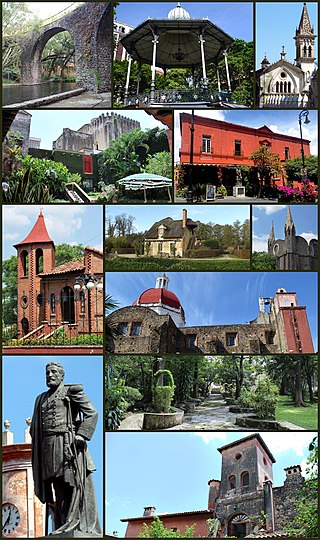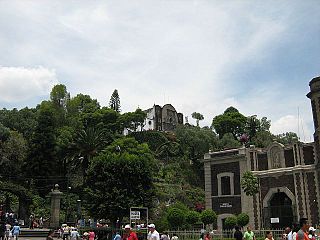
Our Lady of Guadalupe, also known as the Virgin of Guadalupe, is a Catholic title of Mary, mother of Jesus associated with a series of five Marian apparitions to a Mexican peasant named Juan Diego and his uncle, Juan Bernardino, which are believed to have occurred in December 1531, when the Mexican territories were under the Spanish Empire.

Tonantzin is a Nahuatl title composed of to- "our" + nān "mother" + -tzin "(honorific suffix)". When addressing Tonantzin directly, males use the suffixed vocative form Tonāntziné [], and females use the unsuffixed vocative form Tonāntzín [].

Cuernavaca is the capital and largest city of the state of Morelos in Mexico. Along with Chalcaltzingo, it is likely one of the origins of the Mesoamerican civilization. Olmec works of art, currently displayed in the Museum of Anthropology in Mexico City were found in the Gualupita III archeological site.

Gustavo A. Madero is the northernmost borough of Mexico City.

Cuautitlán Izcalli is a city and one of the 125 municipalities that make up the State of Mexico. Its municipal seat is Cuautitlán Izcalli. It is located in the Valley of Mexico area, and is part of the Metropolitan area of Mexico City. It borders to the north and northwest with Tepotzotlán, to the northeast and to the east with Cuautitlán, to the south with Tlalnepantla de Baz, to the southeast with Tultitlán, to the southwest with Atizapán de Zaragoza and to the west with the municipality of Nicolás Romero.

The Basilica of Santa María de Guadalupe, officially called Insigne y Nacional Basílica de Santa María de Guadalupe is a basilica of the Catholic Church, dedicated to the Virgin Mary in her invocation of Our Lady of Guadalupe, located at the foot of the Hill of Tepeyac in the Gustavo A. Madero borough of Mexico City. It belongs to the Primate Archdiocese of Mexico through the Guadalupana Vicariate, which since November 4, 2018, is in the care of Monsignor Efraín Hernández Díaz, who has the title of general and episcopal vicar of Guadalupe and abbot of the basilica.

The Cumbres de Majalca National Park is a national park in the Mexican state of Chihuahua located 88 km northwest of the city of Chihuahua. The park showcases extraordinary rock formations that have been shaped by wind and water erosion. The park was created by presidential decree in 1939 encompassing 4,772 hectares to protect the endemic flora and fauna. The park is characterized by pine and oak forest. It is also one of the few areas in Mexico that are inhabited by black bear.

Tepeyac or the Hill of Tepeyac, historically known by the names Tepeyacac and Tepeaquilla, is located inside Gustavo A. Madero, the northernmost delegación or borough of Mexico City. According to the Catholic tradition, it is the site where Saint Juan Diego met the Virgin of Guadalupe in December 1531, and received the iconic image of the Lady of Guadalupe. The Basilica of Our Lady of Guadalupe located there is one of the most visited Catholic shrines in the world. Spanish colonists erected a Catholic chapel at the site, Our Lady of Guadalupe, "the place of many miracles." It forms part of the Sierra de Guadalupe mountain range.

The Basilica of Guadalupe or Santuario de Nuestra Señora de Guadalupe is a Roman Catholic church located in the metropolitan area of Monterrey, Nuevo León, Mexico.

Alonso de Montúfar y Bravo de Lagunas, O.P., was a Spanish Dominican friar and prelate of the Catholic Church, who ruled as the second Archbishop of Mexico from 1551 to his death in 1572. He approved and promoted the devotion to Our Lady of Guadalupe that arose during his reign.

Mapastepec is a town and municipality in the Mexican state of Chiapas in southern Mexico. Its name derives from the place name mapachtepec, "Hill of the Raccoon", a compound of the Nahuatl words mapachi ("raccoon") and tepetl ("mountain").
Tacubaya is a working-class area of west-central Mexico City, in the borough of Miguel Hidalgo, consisting of the colonia Tacubaya proper and adjacent areas in other colonias, with San Miguel Chapultepec sección II, Observatorio, Daniel Garza and Ampliación Daniel Garza being also considered part of Tacubaya.
Los Remedios National Park is a national park in Mexico, located in the far west of the municipality of Naucalpan in Mexico State, just northwest of Mexico City. The park was established by federal decree in 1938 with an area of 400 hectares. Within its borders is the Sanctuary of the Virgin of Los Remedios, a colonial-era aqueduct and a pre-Hispanic archaeological zone with a Chichimeca temple. All of these are located in and around the mountain called Cerro Moctezuma. The site was an Aztec observatory and is also believed to be where Hernán Cortés and his men rested after fleeing Tenochtitlan.

Juan Diego Cuauhtlatoatzin, also known simply as Juan Diego, was a Chichimec peasant and Marian visionary. He is said to have been granted apparitions of the Virgin Mary on four occasions in December 1531: three at the hill of Tepeyac and a fourth before don Juan de Zumárraga, then bishop of Mexico. The Basilica of Our Lady of Guadalupe, located at the foot of Tepeyac, houses the cloak (tilmahtli) that is traditionally said to be Juan Diego's, and upon which the image of the Virgin is said to have been miraculously impressed as proof of the authenticity of the apparitions.
Tepeyac is a 1917 film directed by José Manuel Ramos, Carlos E. Gonzáles and Fernando Sáyago rescued by Aurelio de los Reyes and restored by National Autonomous University of Mexico and was Mexico's only surviving Silent film in history.

Fernando Leal was one of the first painters to participate in the Mexican muralism movement starting in the 1920s. After seeing one of his paintings, Secretary of Education José Vasconcelos invited Leal to paint at the Escuela Nacional Preparatoria. The resulting work is Los danzantes de Chalma. Leal also painted a mural dedicated to Simón Bolívar at the Anfiteatro Bolivar, as well as religious murals such as those at the chapel dedicated to the Virgin of Guadalupe at the Basilica Villa in Tepeyac.

Mixcoac is an area of southern Mexico City which used to be a separate town and municipality within the Mexican Federal District until it was made part of Mexico City proper in 1928.

The Sierra de Guadalupe is a mountain range in Mexico. It is found between the borough of Gustavo A. Madero in northern Mexico City and the municipalities of Cuautitlán Izcalli, Tultitlán, Coacalco, Ecatepec and Tlalnepantla, in the State of Mexico. Its highest peak is at 3,055 meters (10,023 ft).
















